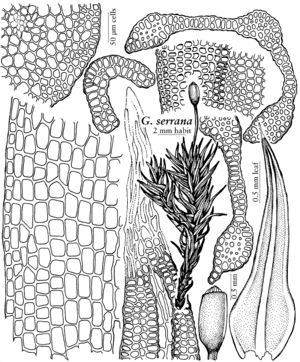Grimmia serrana
Shevock & D. R. Toren, J. Bryol. 24: 143, figs. 1a–f. 2002,.
Plants in flat patches, olivaceous. Stems to 3 cm. Leaves ovate-lanceolate from an ovate base, 2.5–3.5 × 0.6–0.7 mm, both margins plane, costa-like inter-marginal bands 2–4(–5)-stratose, awn to 1 mm, not decurrent, narrowly attached, acuminate, costa narrow proximally; basal juxtacostal laminal cells short- to long-rectangular, sinuose, thick lateral-walled, dense; basal marginal laminal cells quadrate to short-rectangular, sinuose, thick lateral-walled, not hyaline; medial laminal cells quadrate, slightly sinuose, thick-walled; distal laminal cells 1–3-stratose, oblate to rectangular, thick-walled. Perichaetial leaves enlarged. Seta straight to slightly arcuate, to 3.5 mm. Capsule occasionally present, exserted, pale yellow, ovoid, exothecial cells oblong, thin-walled, stomata absent, annulus of 1–2 rows of quadrate, thick-walled cells, operculum short straight, peristome fully developed, not perforate, not split. Calyptra cucullate.
Habitat: Humid to dry areas, exposed granite, metamorphic rock, metavolcanic rocks and basalt, montane woodlands
Elevation: moderate elevations (700-1400 m)
Discussion
According to the original description, Grimmia serrana is known only from “localities along the western slope of the Sierra Nevada and two occurrences in the northern Coast Range.” Despite its limited distribution, H. C. Greven (2003) found it to be quite common in the area. With its thick, concave leaves with plane margins and flat costa, G. serrana is best placed in subg. Litoneuron. This is further supported by a number of other features shared by, but not unique to, all members of that subgenus, including a well-developed stem central strand, dioicous sexuality, and long-exserted capsule with a multi-layered, thick-walled annulus. Grimmia serrana is most readily identified by a prominent, costa-like, multi-layered band of cells that run along the laminal margin distally and become submarginal proximally. This inflated band is unique to this species and readily separates it from all other members of subg. Litoneuron. As stated by Muñoz et al., G. serrana is most likely to be confused with G. ovalis. Both are robust species with ovate-lanceolate leaves from an ovate base. However, the prominent intermarginal bands of G. serrana will readily separate these species.
Selected References
None.

